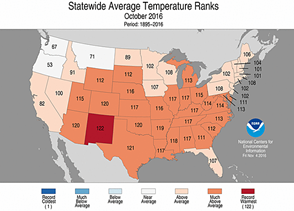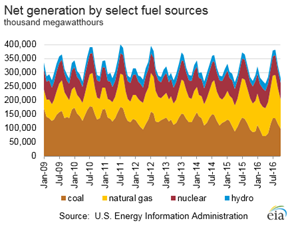
Electricity Monthly Update
Highlights: October 2020
- Wholesale natural gas prices rose rapidly through the month, setting both new 12-month low and 12-month high prices at several locations during October 2020.
- Daily electricity system demand remained low in most regions as a result of mild Fall weather.
- The average revenue per kilowatthour decreased by almost 55% in Nevada compared to the previous October due to a one-time bill credit approved by the state energy regulators.
Key indicators
Thanksgiving 2020 electricity demand pattern is similar to previous Thanksgivings
Source: U.S. Energy Information Administration, Hourly Electric Grid Monitor.
U.S. electricity demand on Thanksgiving this year largely followed the same unique pattern normally seen on this day despite social distancing and other responses to the COVID-19 pandemic disrupting the usual holiday celebrations of many Americans. However, the level of electricity demand was lower overall compared with previous years because of this year’s milder temperatures.
On a typical winter weekday, U.S. electricity demand has two distinct peaks: a smaller peak in the morning, as many people wake up and prepare for the day, and a larger peak in the evening, as many people come home from work, cook dinner, and do household chores. By contrast, on Thanksgiving Day, electricity demand usually experiences a particularly large morning peak that is closer to midday, when many Americans gather and use ovens and other electric cooking equipment to prepare large Thanksgiving meals. Electricity demand then peaks to a smaller degree in the evening, reflecting a departure from normal evening routines.
This Thanksgiving, responses to the pandemic changed travel plans for many Americans and likely reduced the number of large gatherings this year. Yet, Thanksgiving electricity demand generally followed the same pattern seen in previous Thanksgivings, most likely because households held smaller but similar holiday celebrations as in previous years. The electricity demand pattern on Black Friday closely resembles a weekend day normally, and the same was true for this year as well.
At the national level, Thanksgiving electricity demand this year was lower overall compared with previous years, largely because of milder temperatures. Heating degree days for Thanksgiving week were 22% lower than normal and 13% lower than last year. The regional graphs below show the impact of temperature on Thanksgiving electricity demand.
Source: U.S. Energy Information Administration, Hourly Electric Grid Monitor; National Oceanic and Atmospheric Administration, Aviation Weather Center and National Centers for Environmental Information.
Note: New York City temperatures serve as a proxy for temperatures across the New York State in this analysis since much of the electricity demand in the state is concentrated in the New York City area. This graph excludes all holidays except for Thanksgiving and Black Friday.
Based on New York Independent System Operator (NYISO) data, Thanksgiving electricity demand in New York State this year followed a similar pattern as previous Thanksgivings with a larger peak around midday and a smaller evening peak.
Two of the primary drivers of short-term changes in electricity demand are temperature and day of the week. Electricity demand is usually highest during very cold or very hot weather and lowest during mild temperatures. Weekend electricity demand tends to be lower than weekday electricity demand because schools and many businesses are closed.
As shown in the graph above, less electricity is consumed on Thanksgiving and Black Friday compared with other temperature-comparable weekdays because many businesses and schools are closed on those days, leading to a weekend-like level of electricity demand.
However, Thanksgiving Day electricity demand this year was particularly low even compared with previous Thanksgivings at 354,877 megawatthours (MWh)—the lowest in five years. This low was mainly a result of warmer temperatures this year; however, reduced Thanksgiving travel and other changes to holiday activities in response to COVID-19 could have also contributed.
As an additional point of comparison, electricity demand in March through May 2020 during the height of the initial COVID-19 response, shown as yellow dots in the graph above, reached lower levels than the typical drop in demand during Thanksgiving.
Source: U.S. Energy Information Administration, Hourly Electric Grid Monitor; National Oceanic and Atmospheric Administration, Aviation Weather Center and National Centers for Environmental Information.
Note: Temperature shown is the flat average of daily average temperatures in Chicago, Illinois; Des Moines, Iowa; Detroit, Michigan; Indianapolis, Indiana; Minneapolis, Minnesota; New Orleans, Louisiana; and St. Louis, Missouri. This graph excludes all holidays except for Thanksgiving and Black Friday.
Thanksgiving electricity demand in the Midcontinent Independent System Operator (MISO) electric system, which spans from Minnesota in the north to Louisiana in the south, followed a similar pattern as in NYISO. Warmer temperatures in the MISO area pushed down Thanksgiving electricity demand to 1,474,488 MWh, the second lowest for the 2016–2020 period. Thanksgiving reductions were also similar to the level of electricity demand experienced during the initial COVID-19 March–May 2020 period.
Source: U.S. Energy Information Administration, Hourly Electric Grid Monitor; National Oceanic and Atmospheric Administration, Aviation Weather Center and National Centers for Environmental Information.
Note: Temperature shown is the flat average of daily average temperatures in Miami, Orlando, and Tampa in Florida. This graph excludes all holidays except for Thanksgiving and Black Friday.
In Florida, unlike in New York and in the MISO area, Thanksgiving electricity demand tends to experience one large daily peak, which is the load shape typically seen during weather warm enough to trigger air conditioning use. Thanksgiving Day electricity demand was noticeably higher this year (593,641 MWh), the highest in five years, and fell closer to the middle of the normal temperature-comparable range than previous Thanksgivings.
The warmer temperatures partly caused the higher electricity demand this Thanksgiving, but other factors may have also contributed. The southern United States has the highest proportion of all-electric homes in the country, and 75% of southern households use electricity for cooking. Because Florida also has the highest proportion of residential electricity customers in the country, all of these factors coupled with possible changes in holiday travel plans this year may have caused the noticeable increase in electricity demand in the state this Thanksgiving.
Principal Contributor:
- Name: April Lee
- Email: April.Lee@eia.gov










